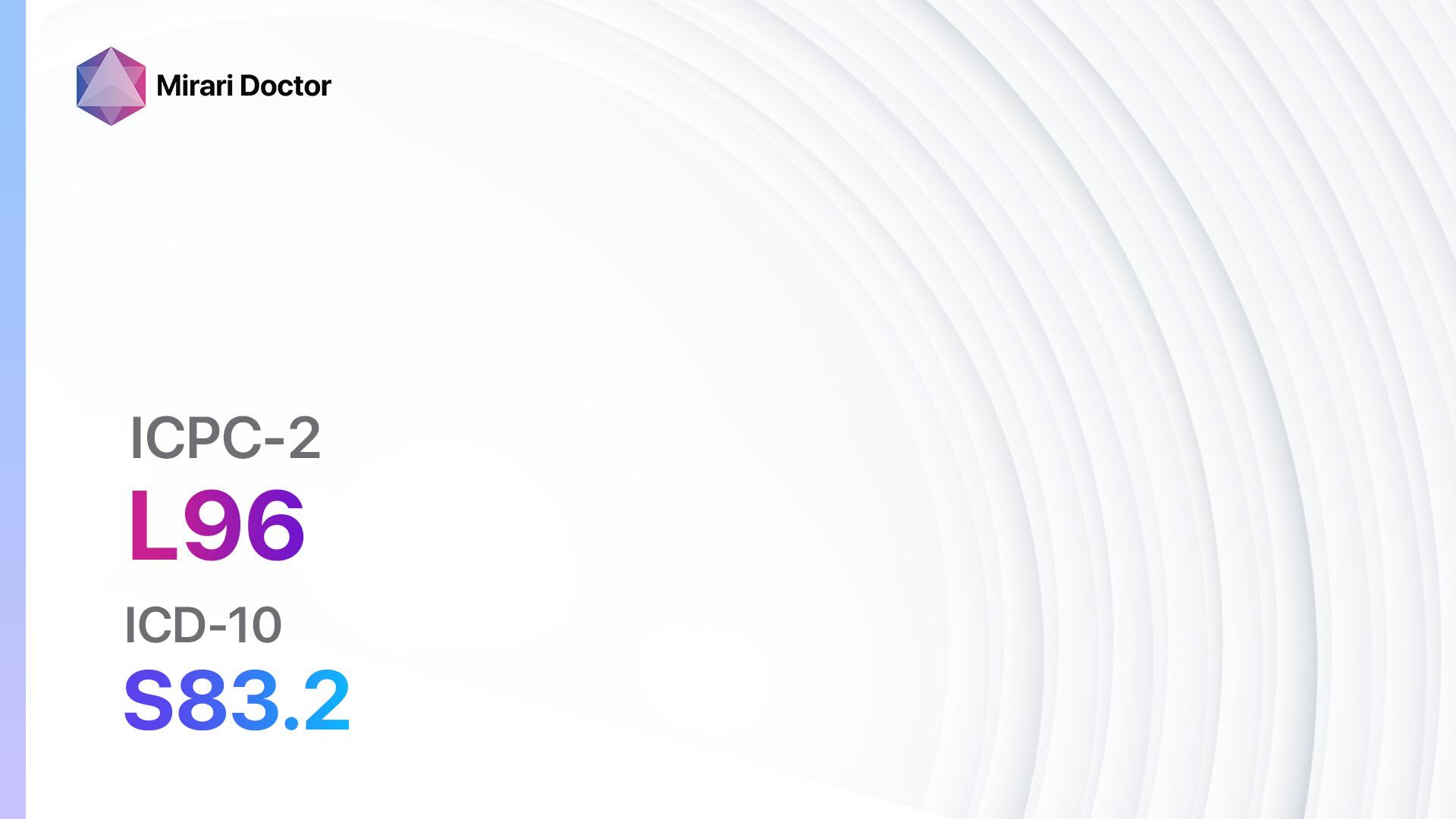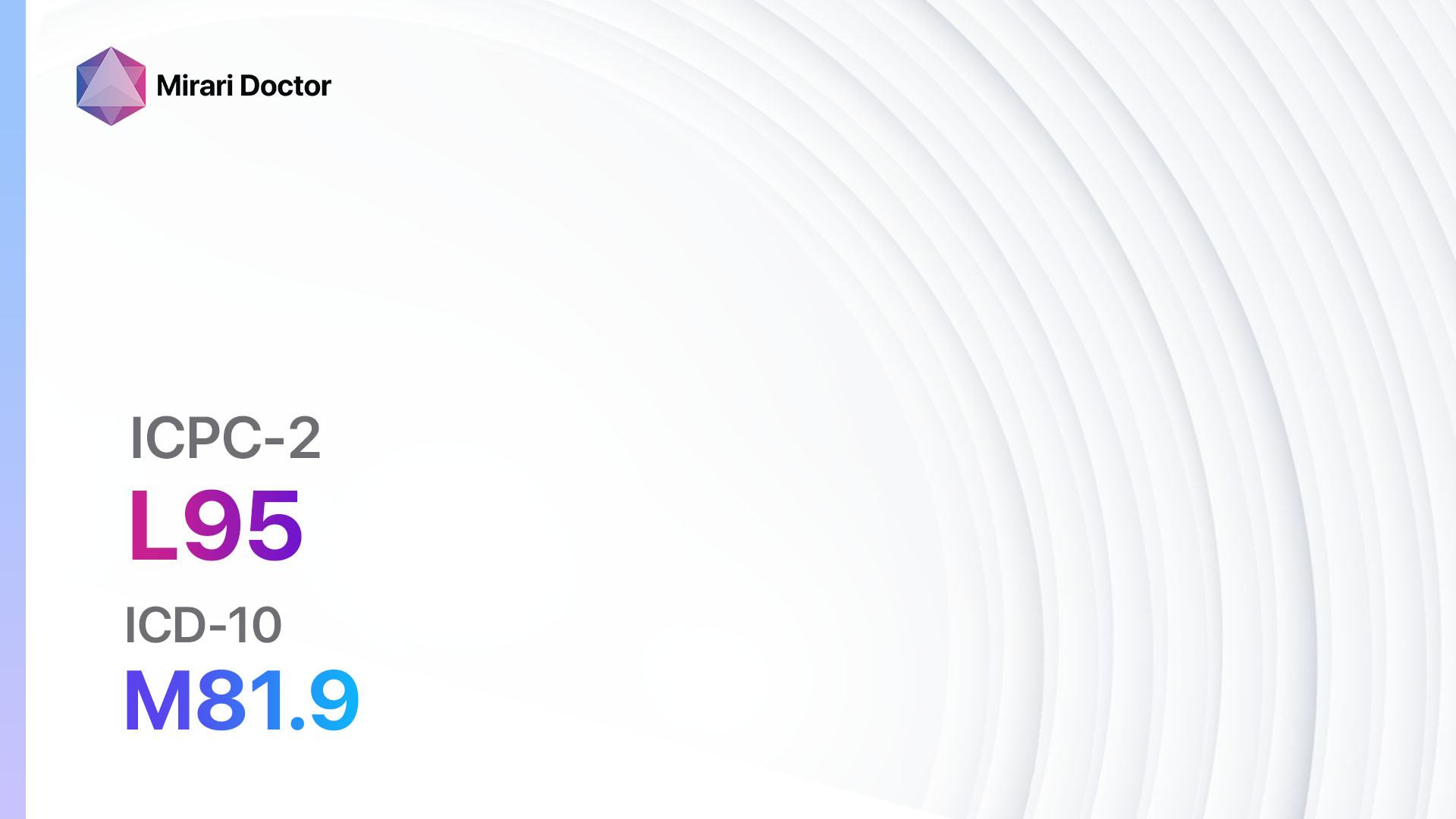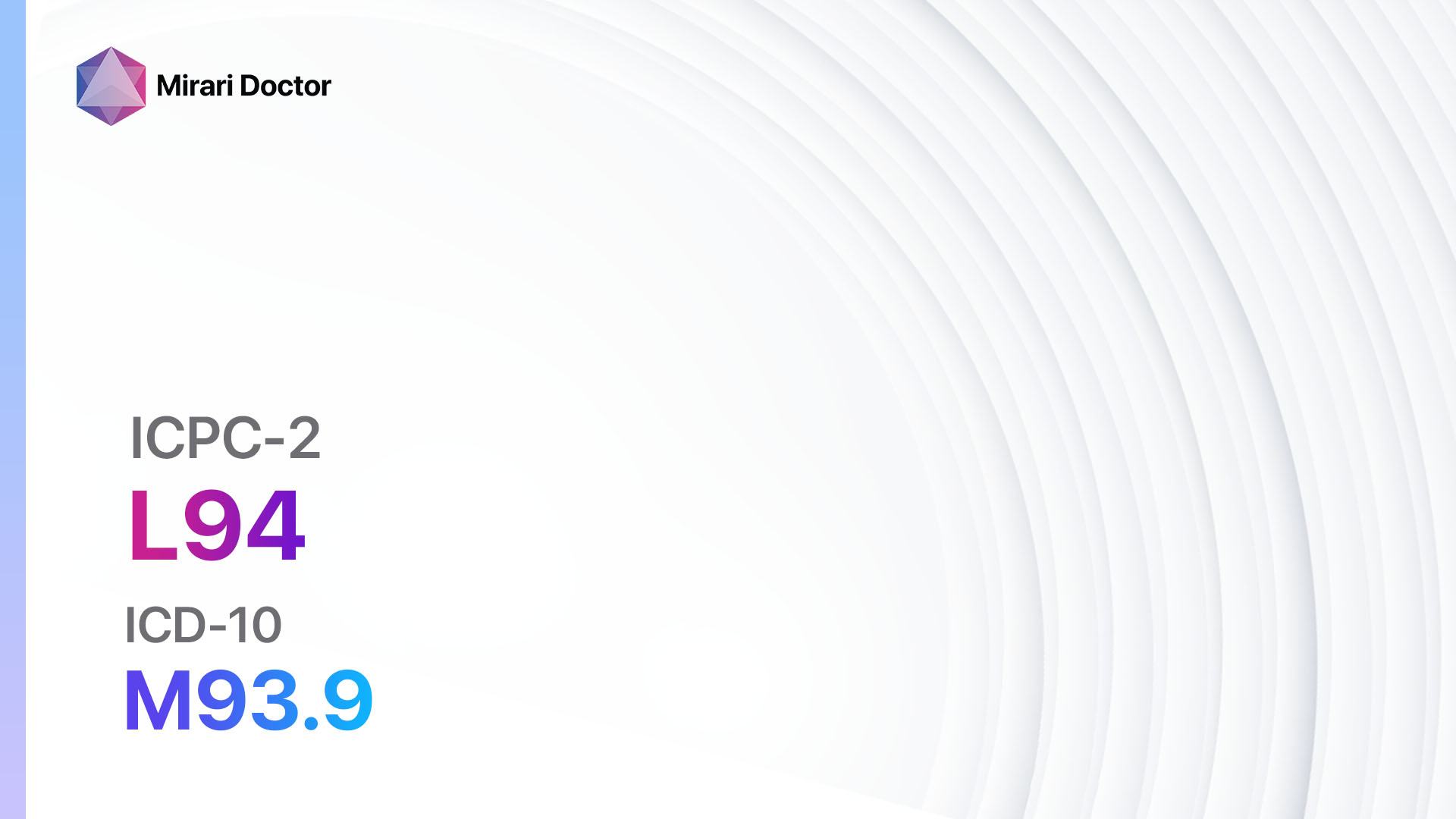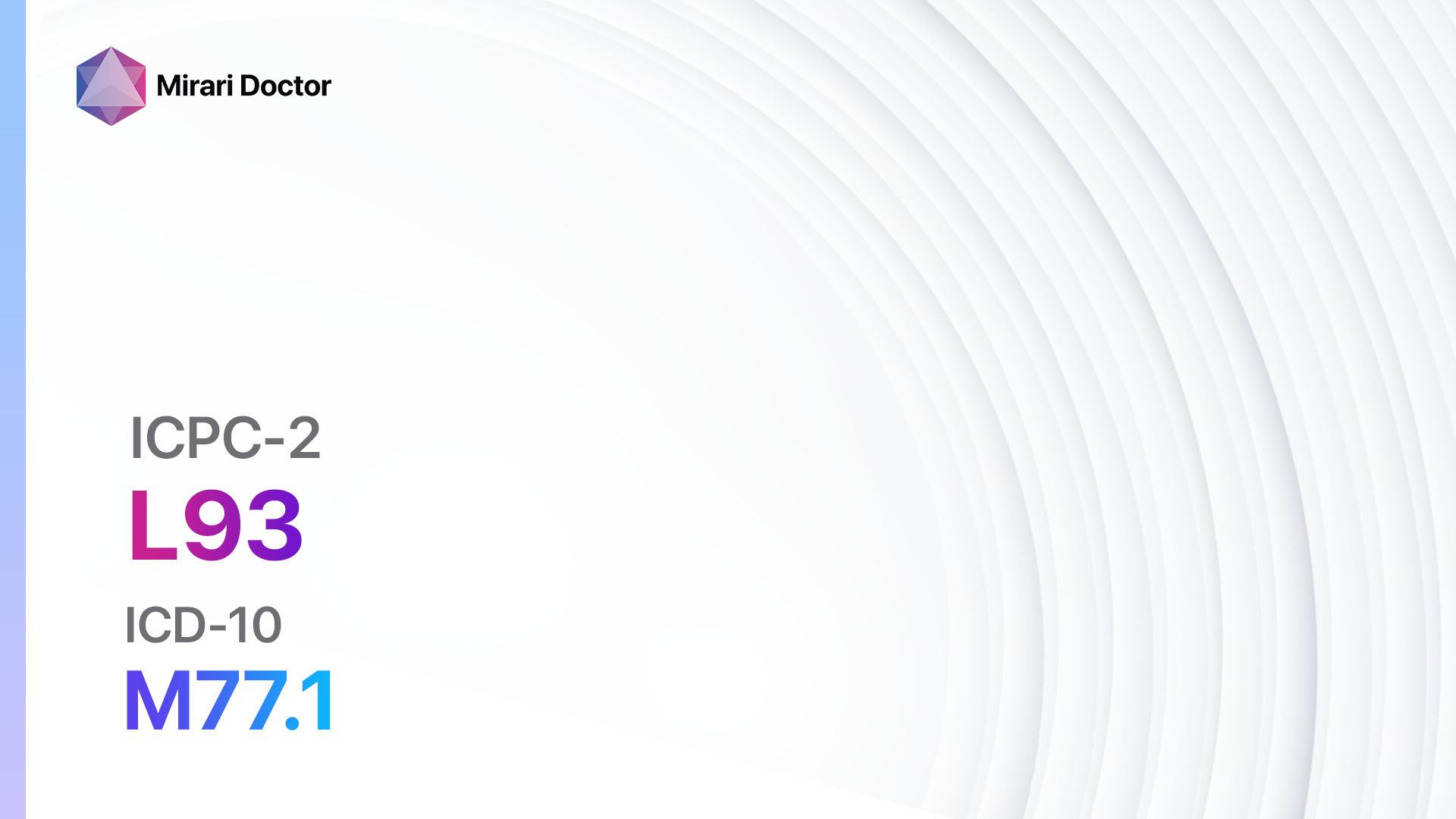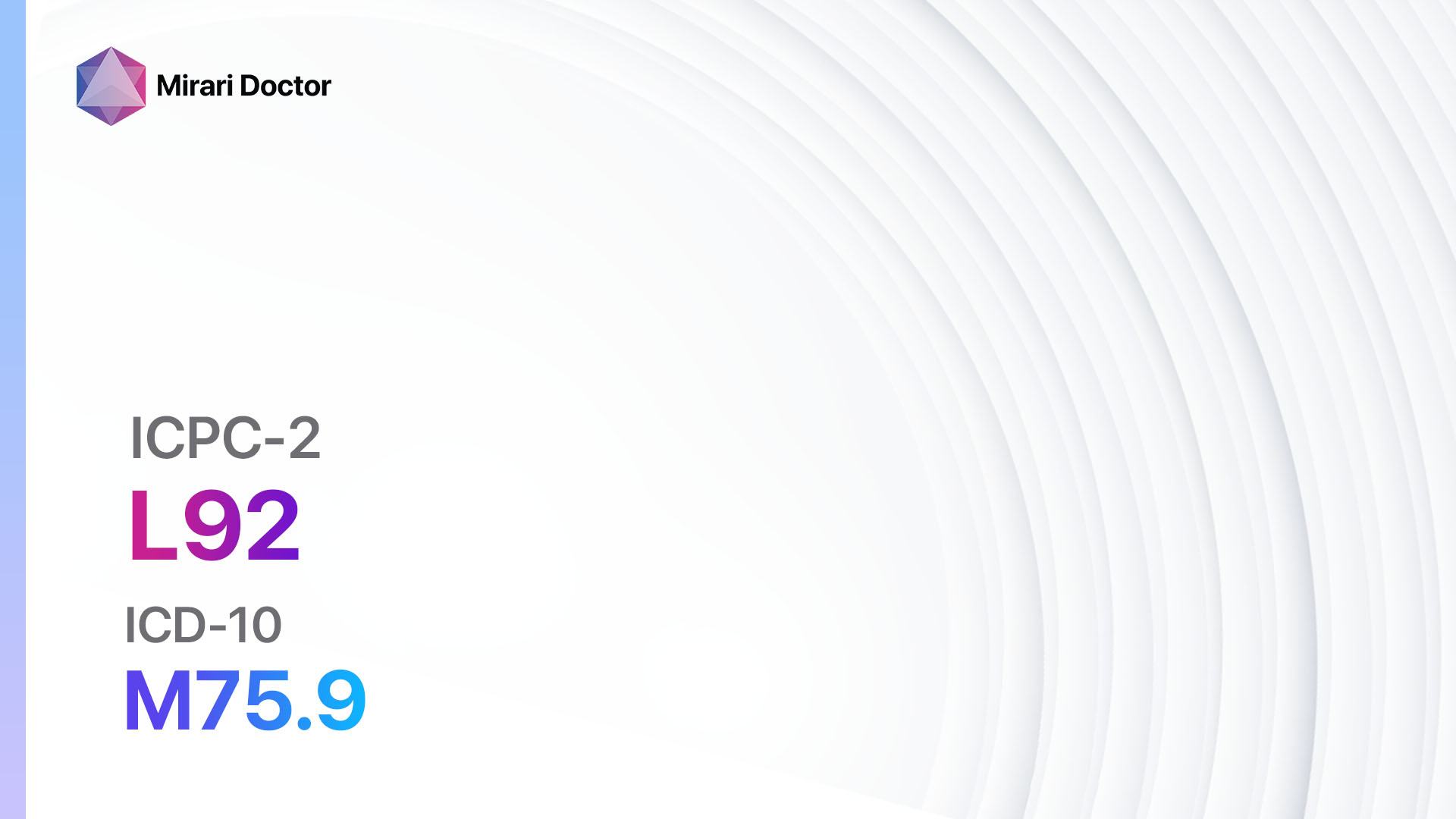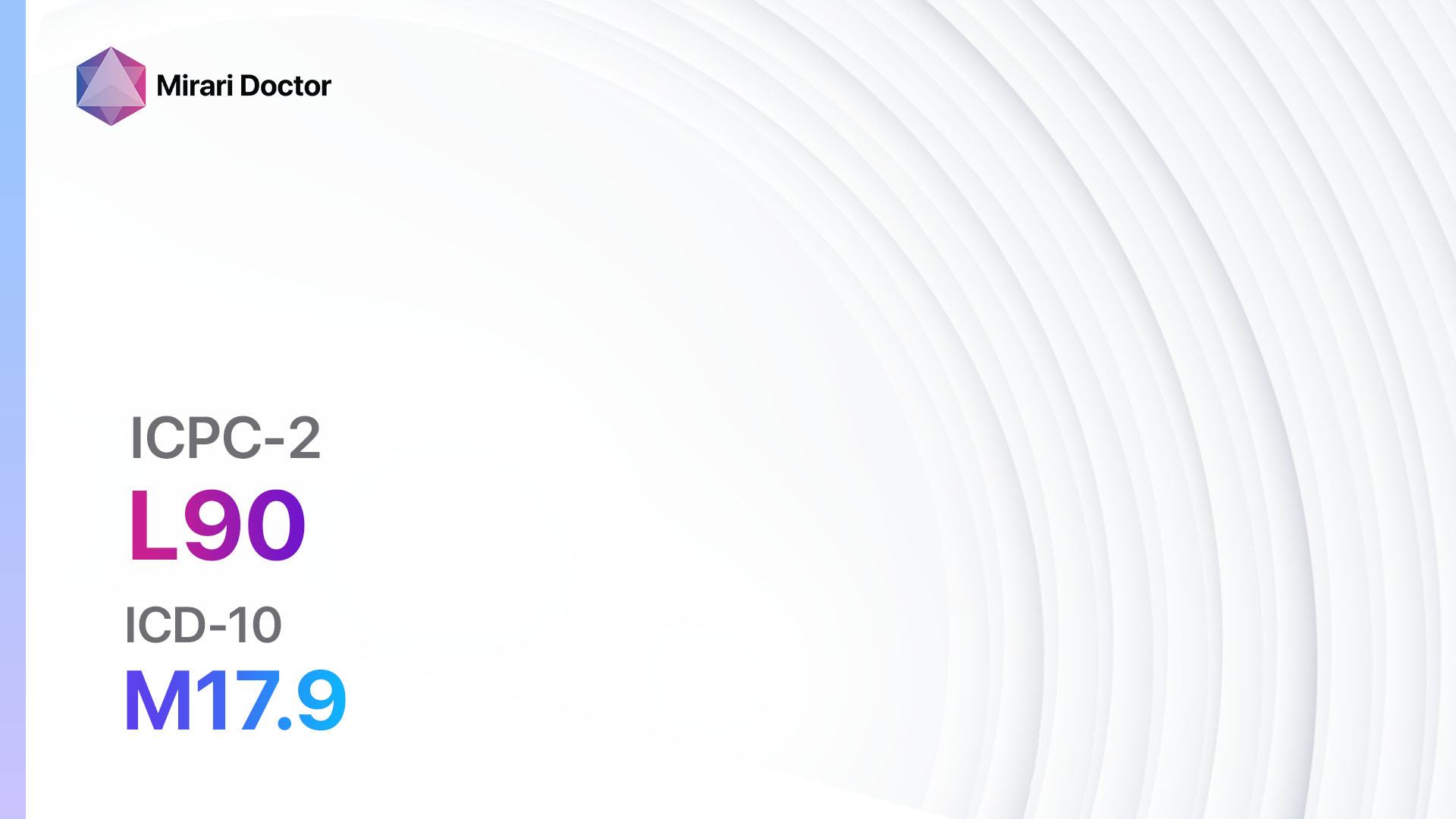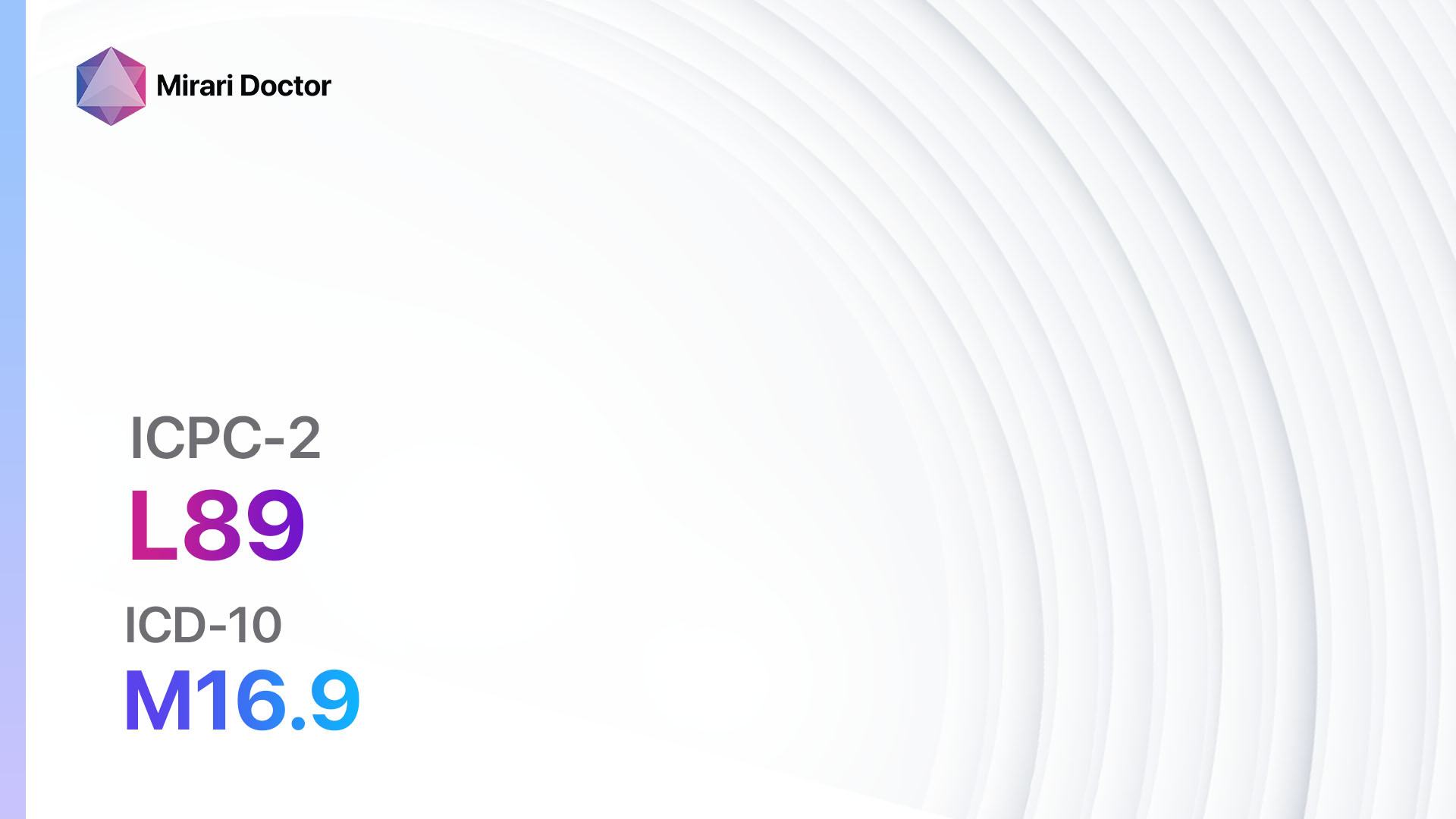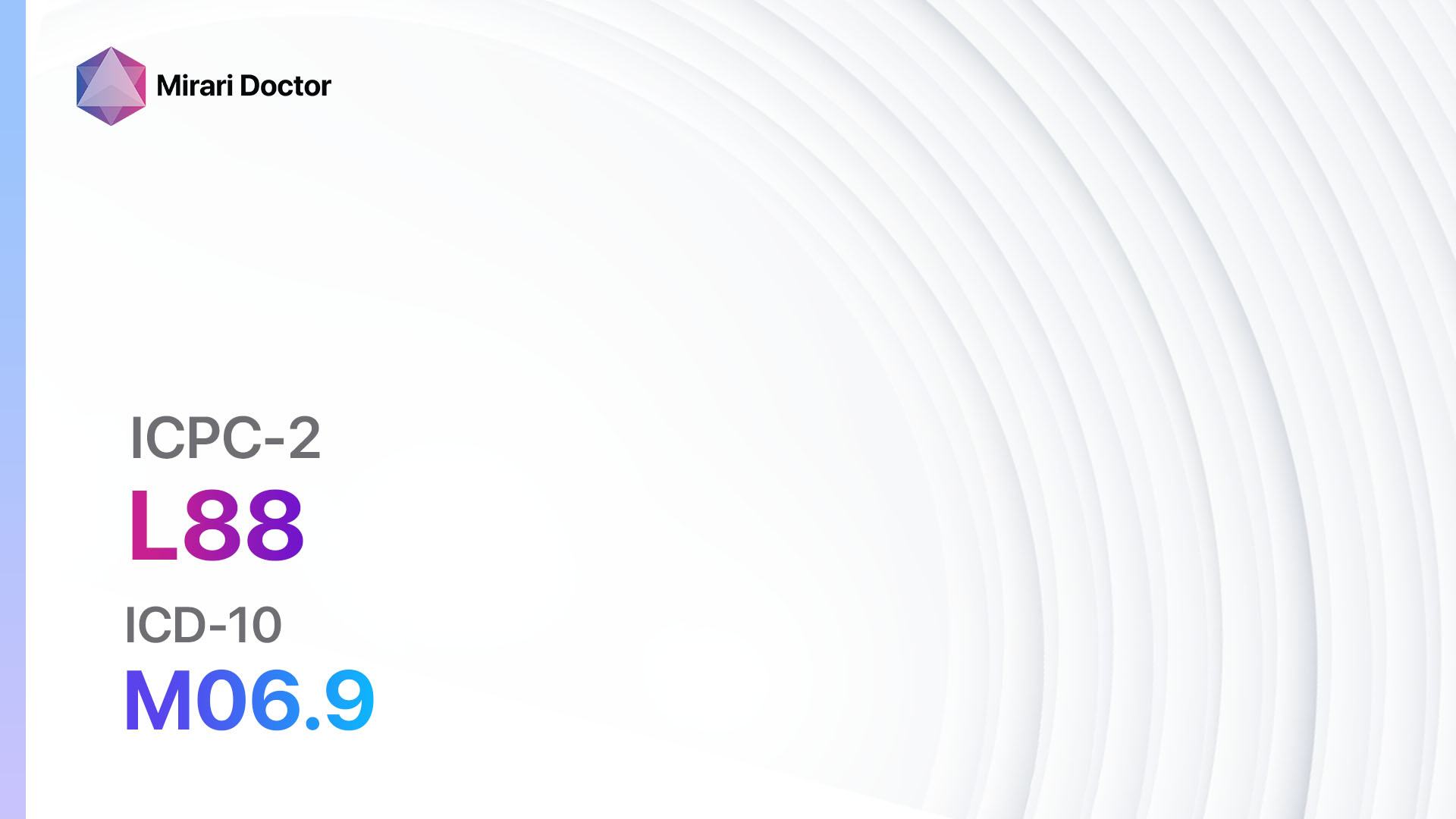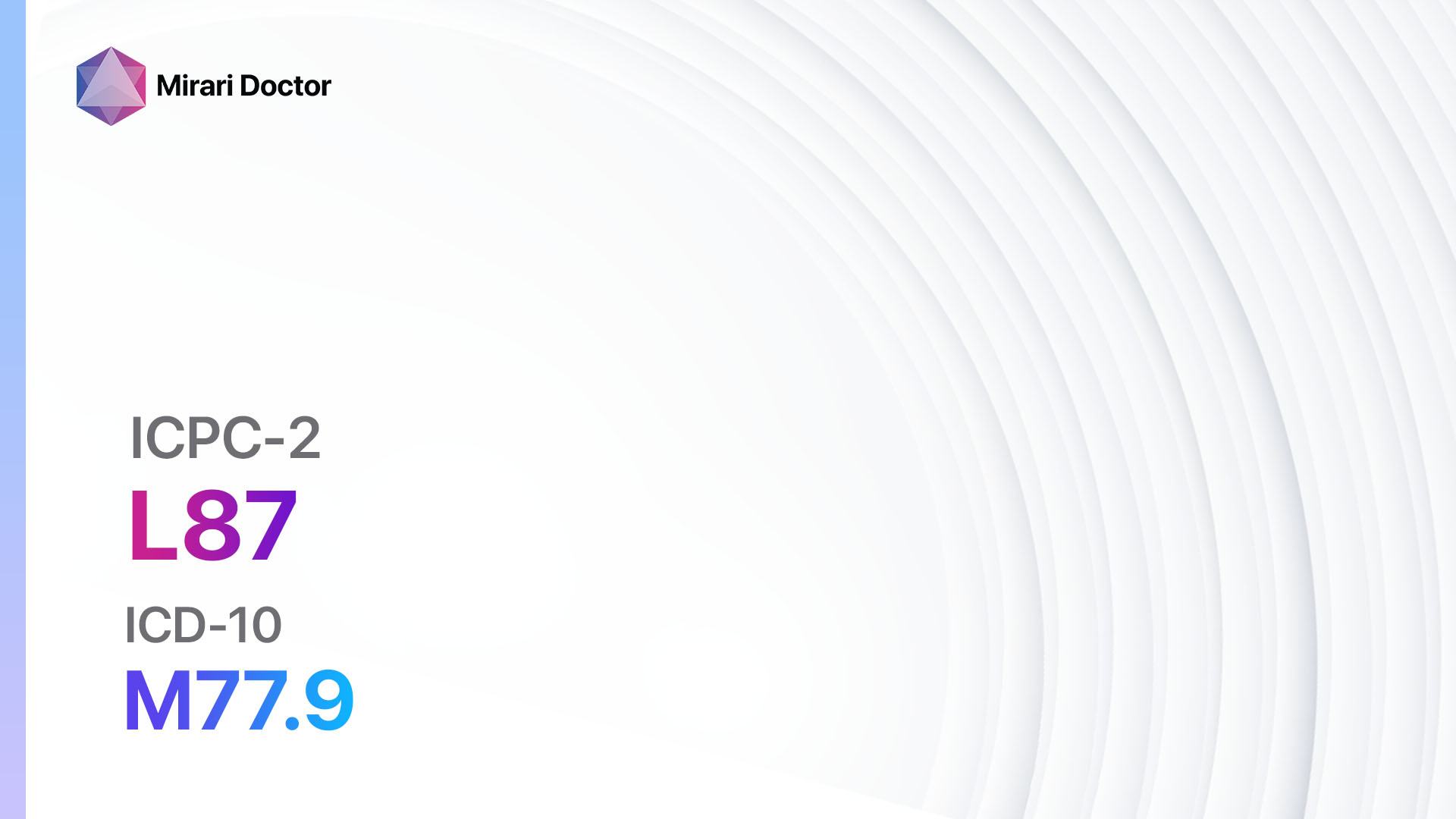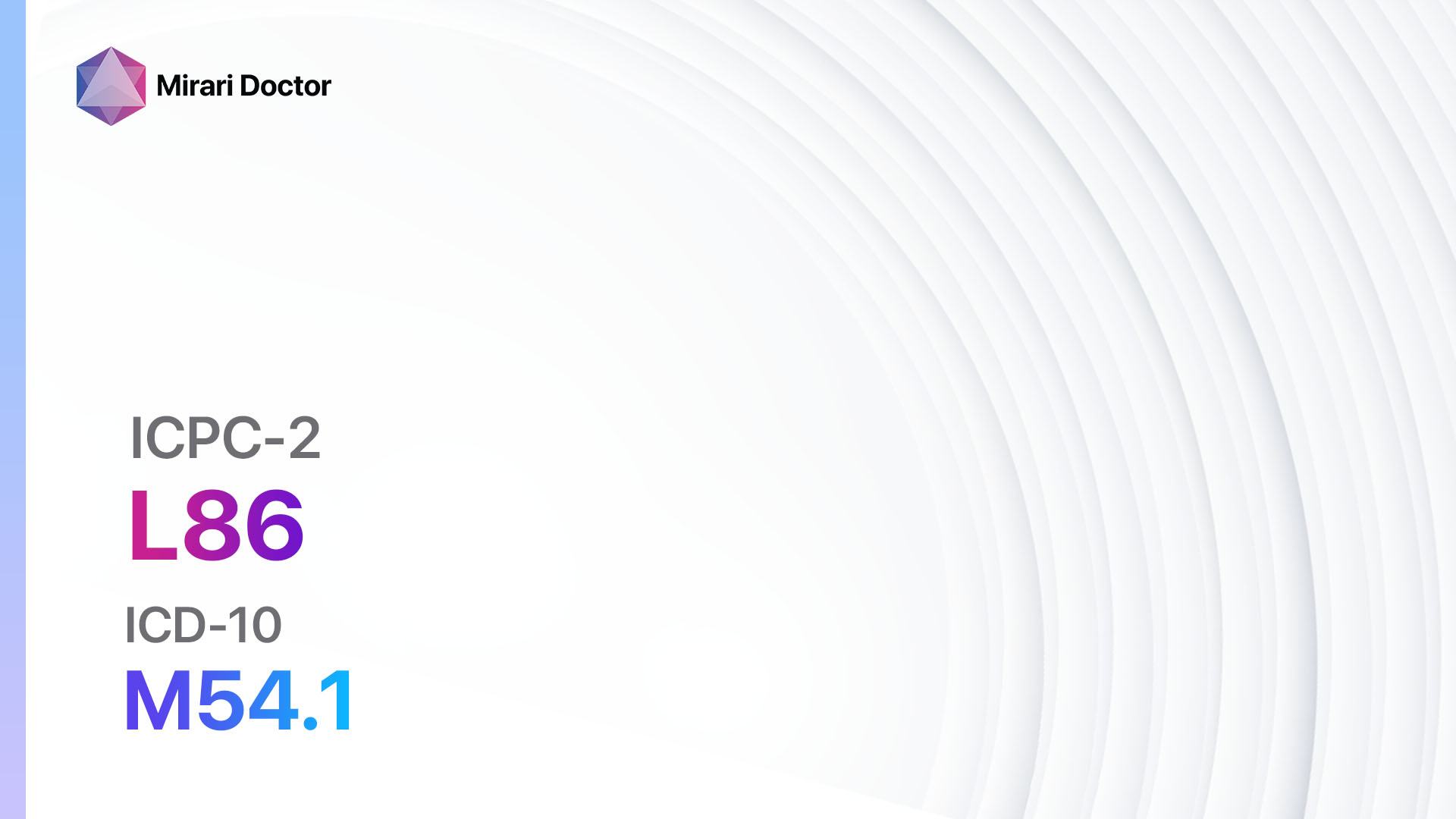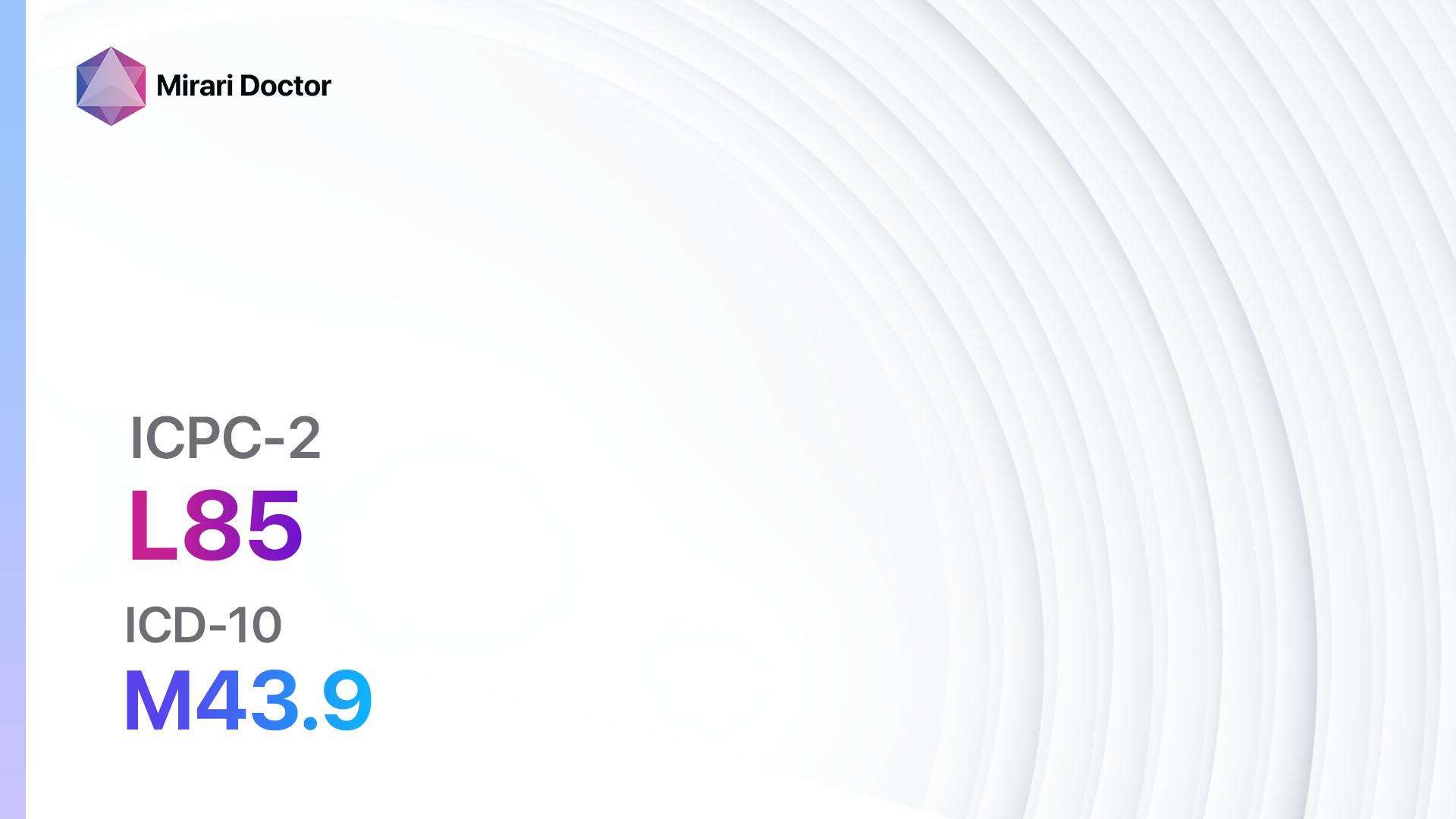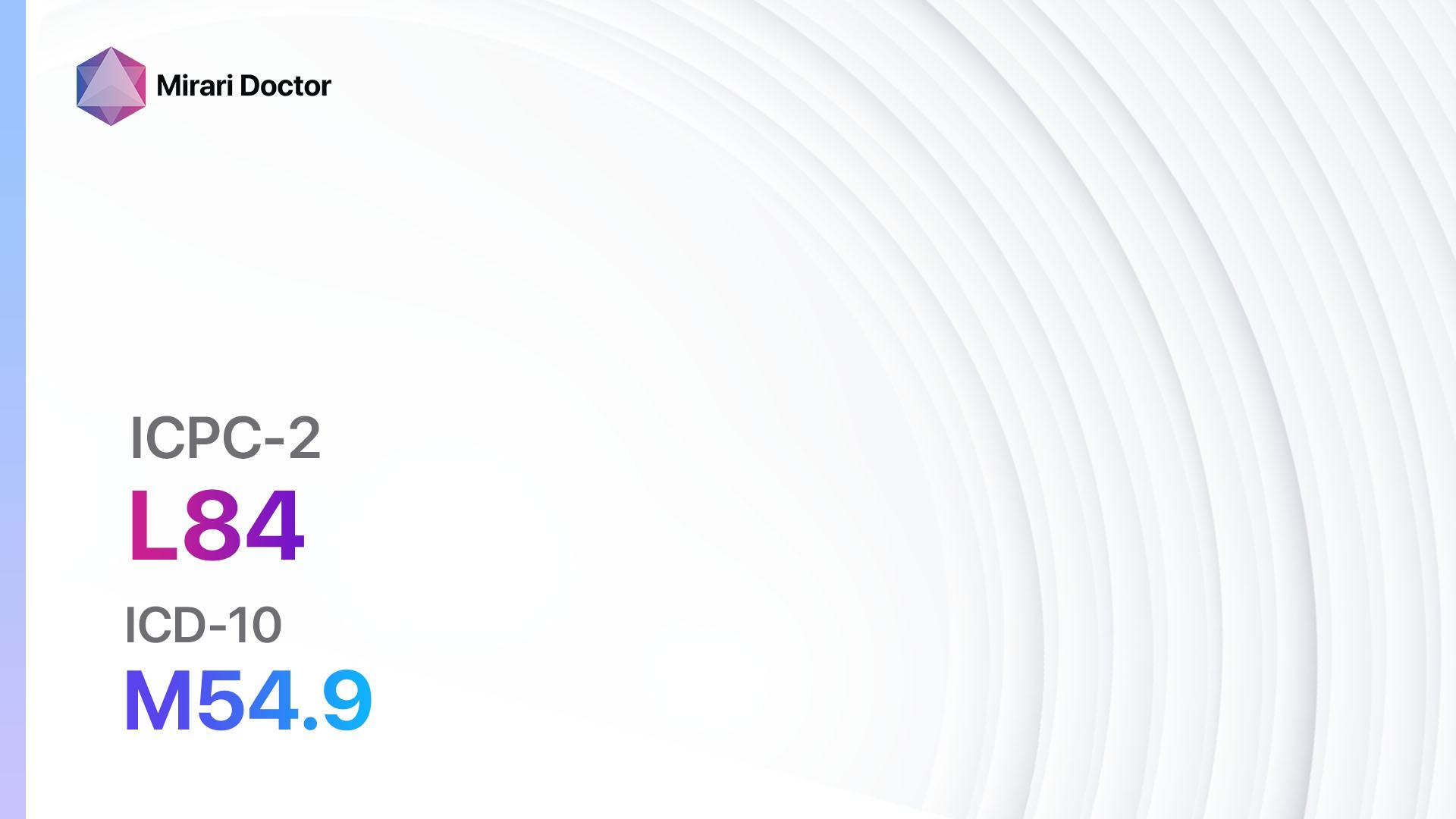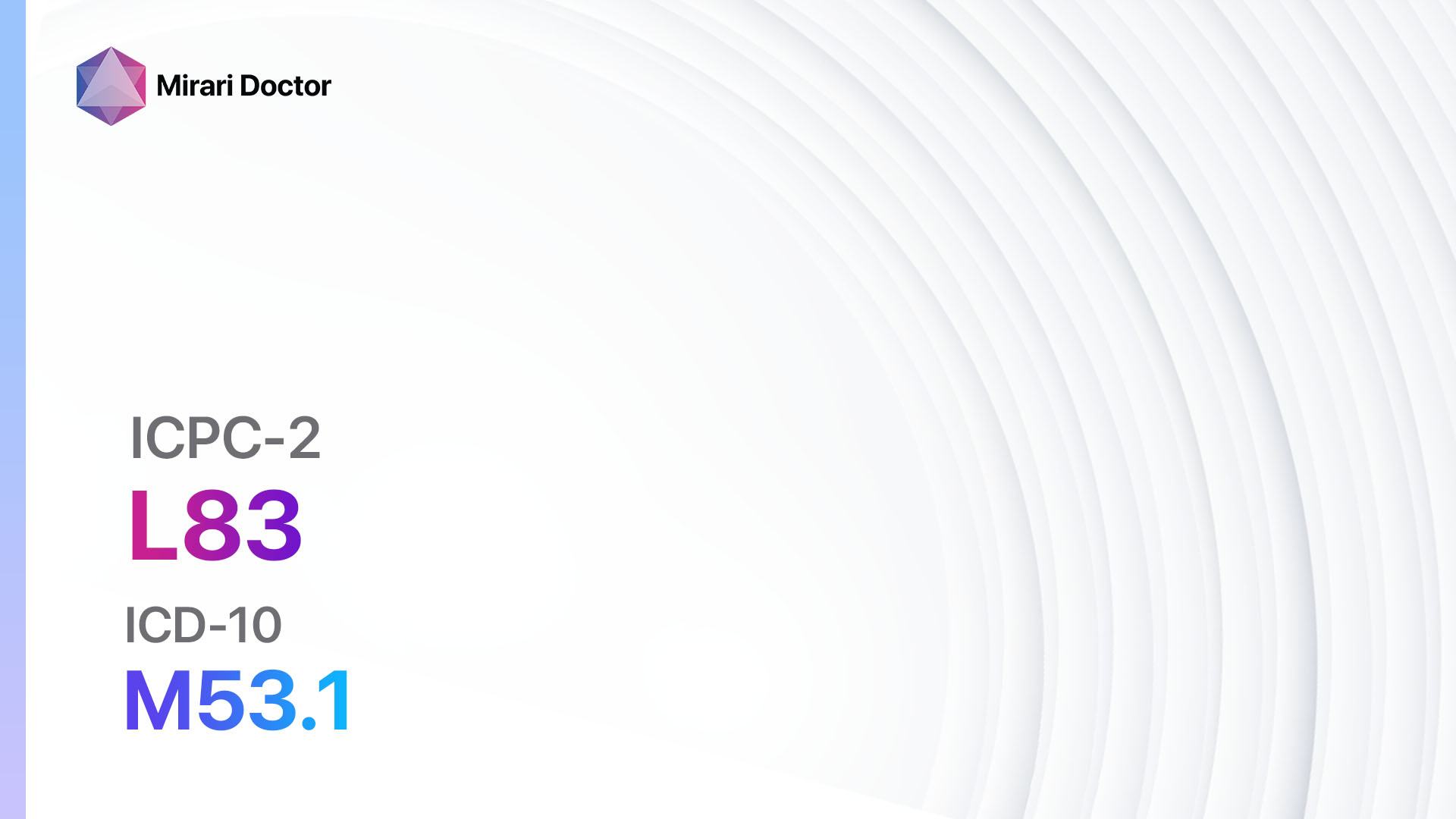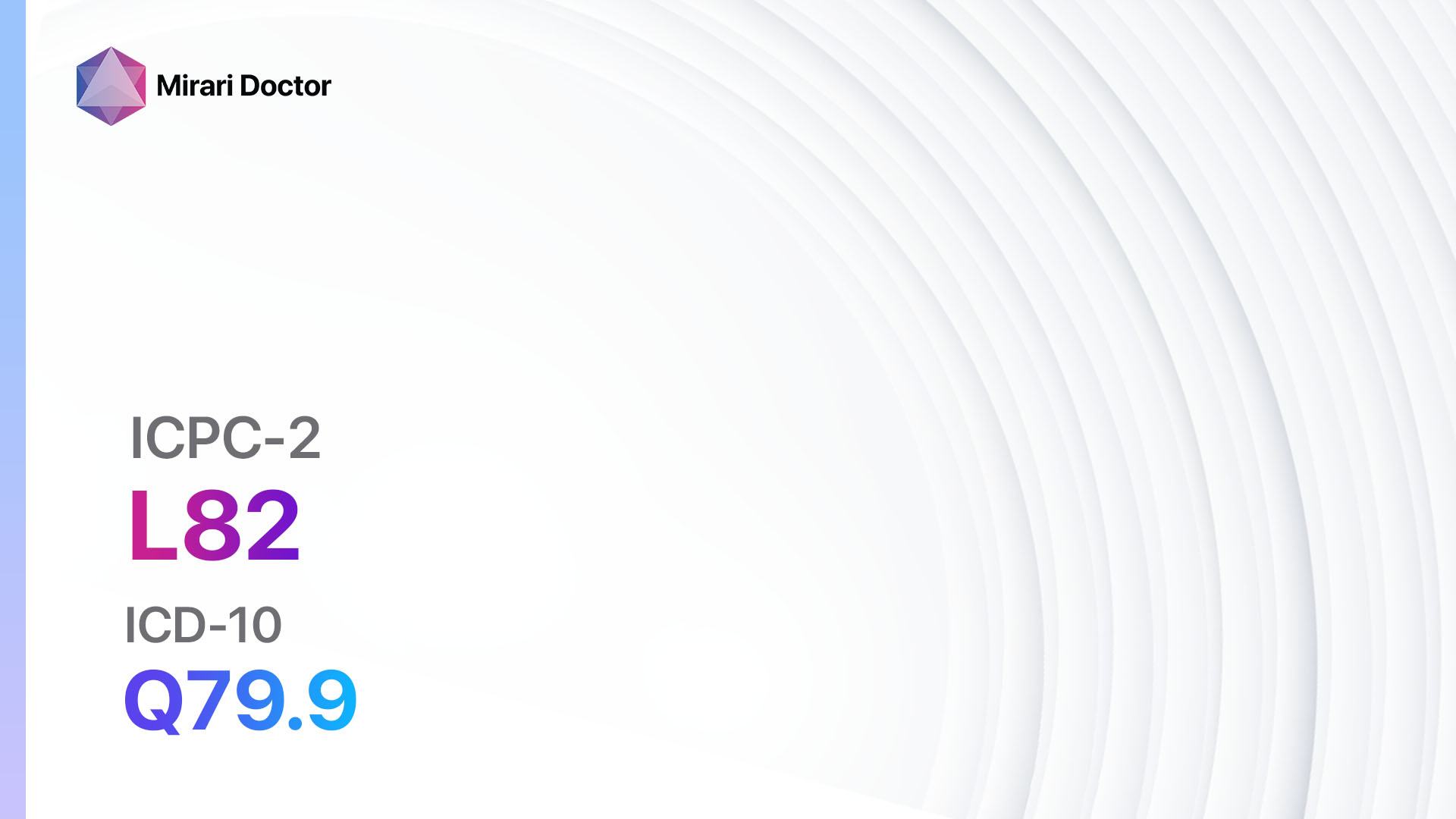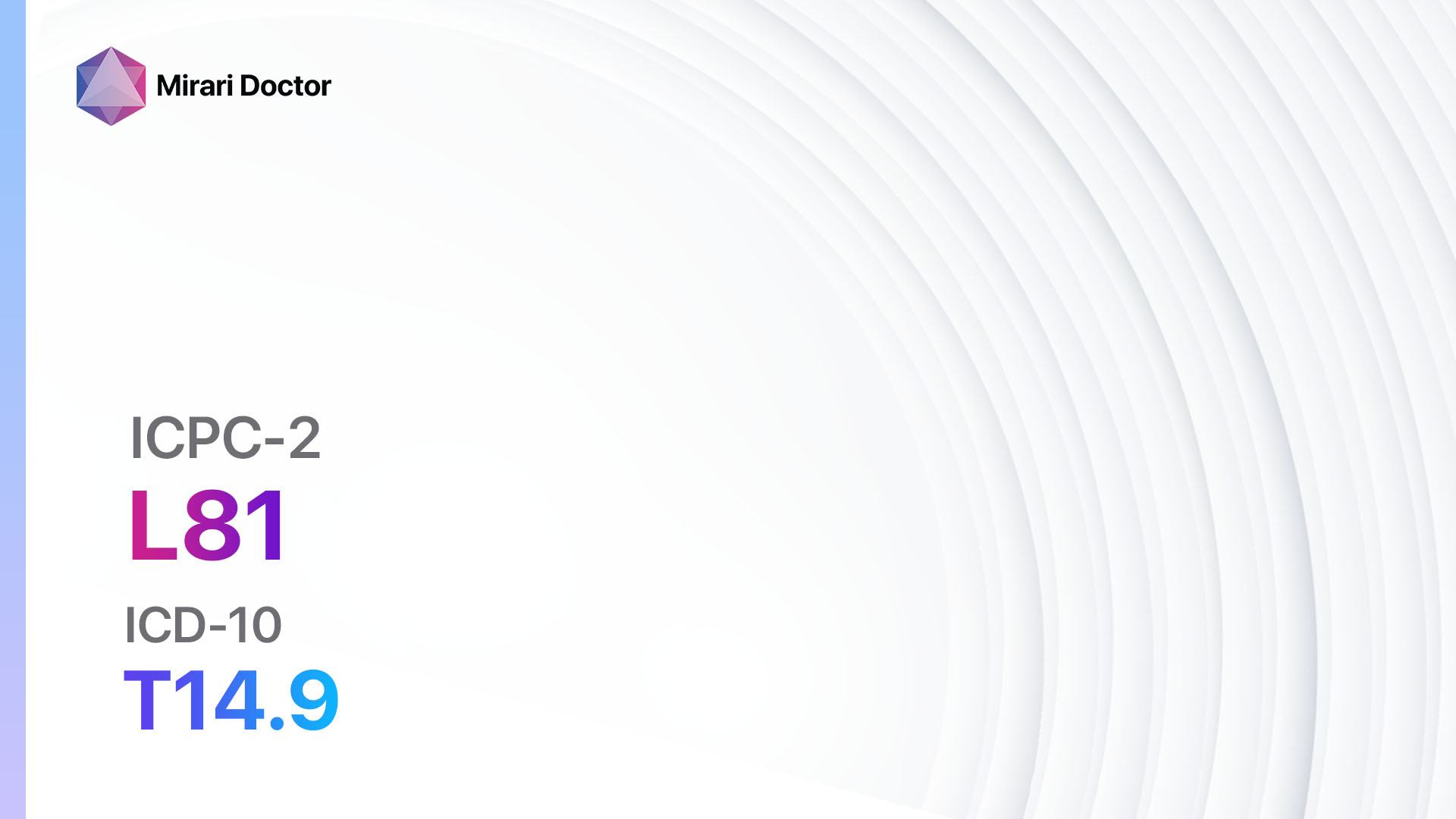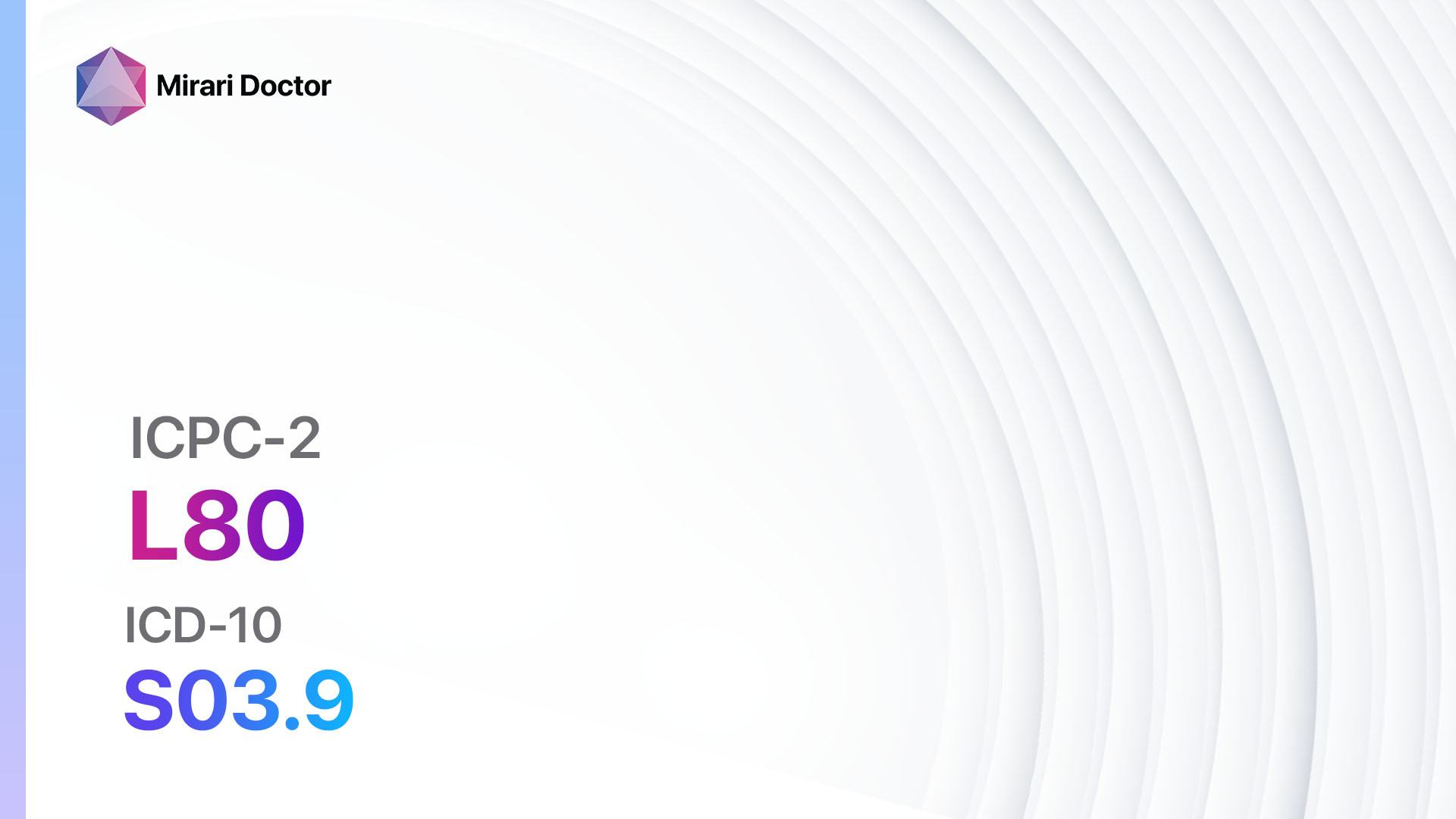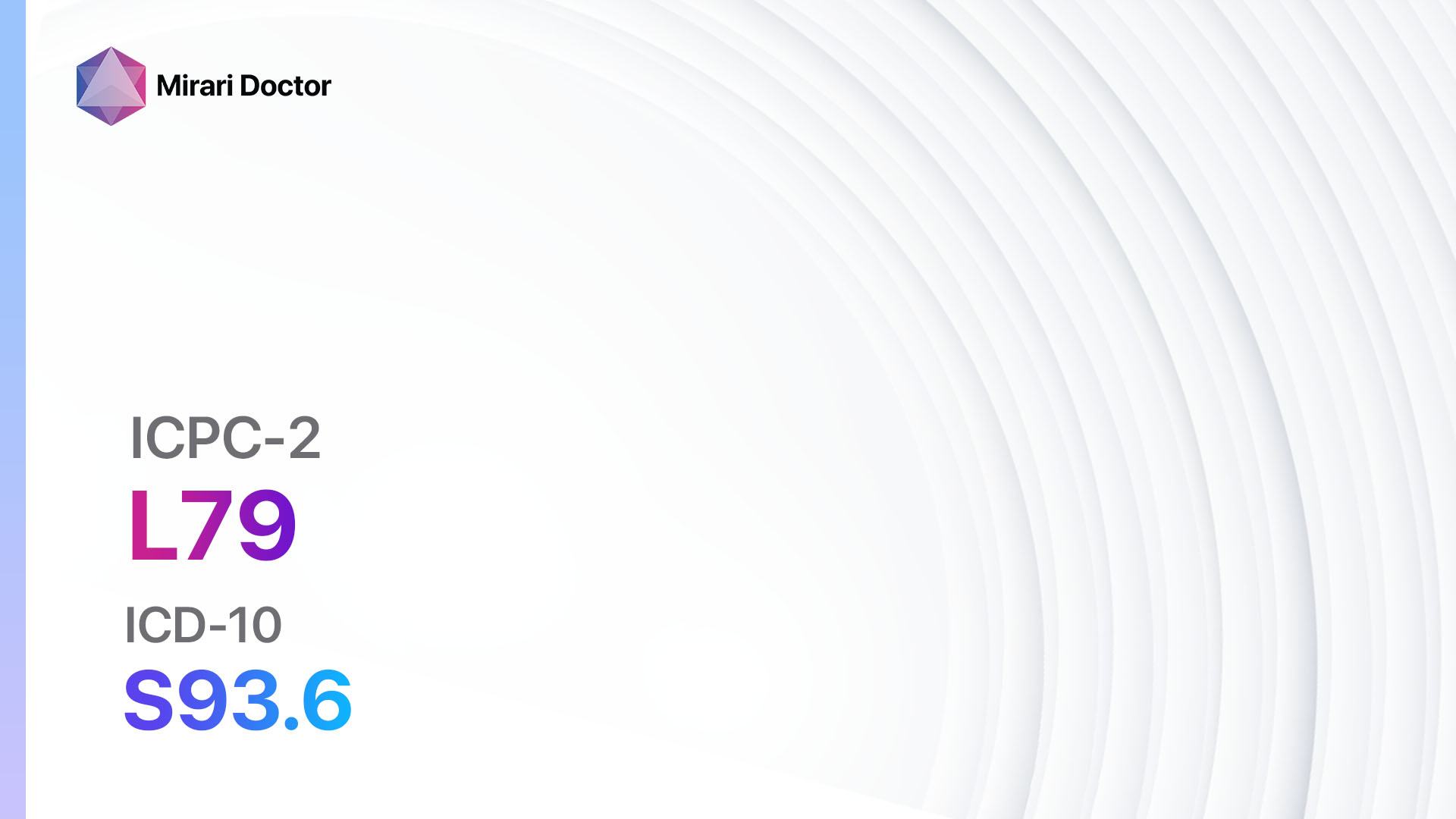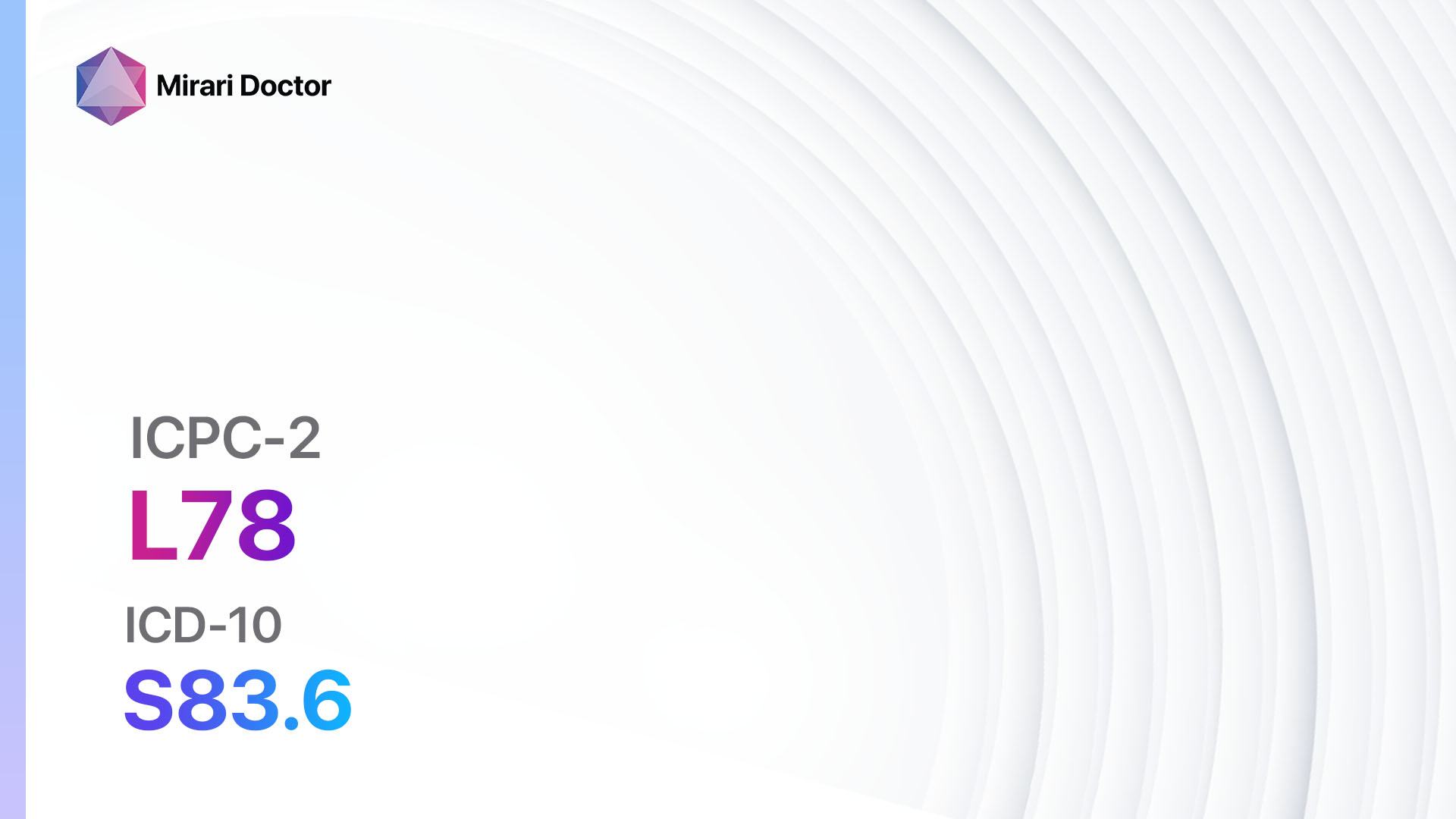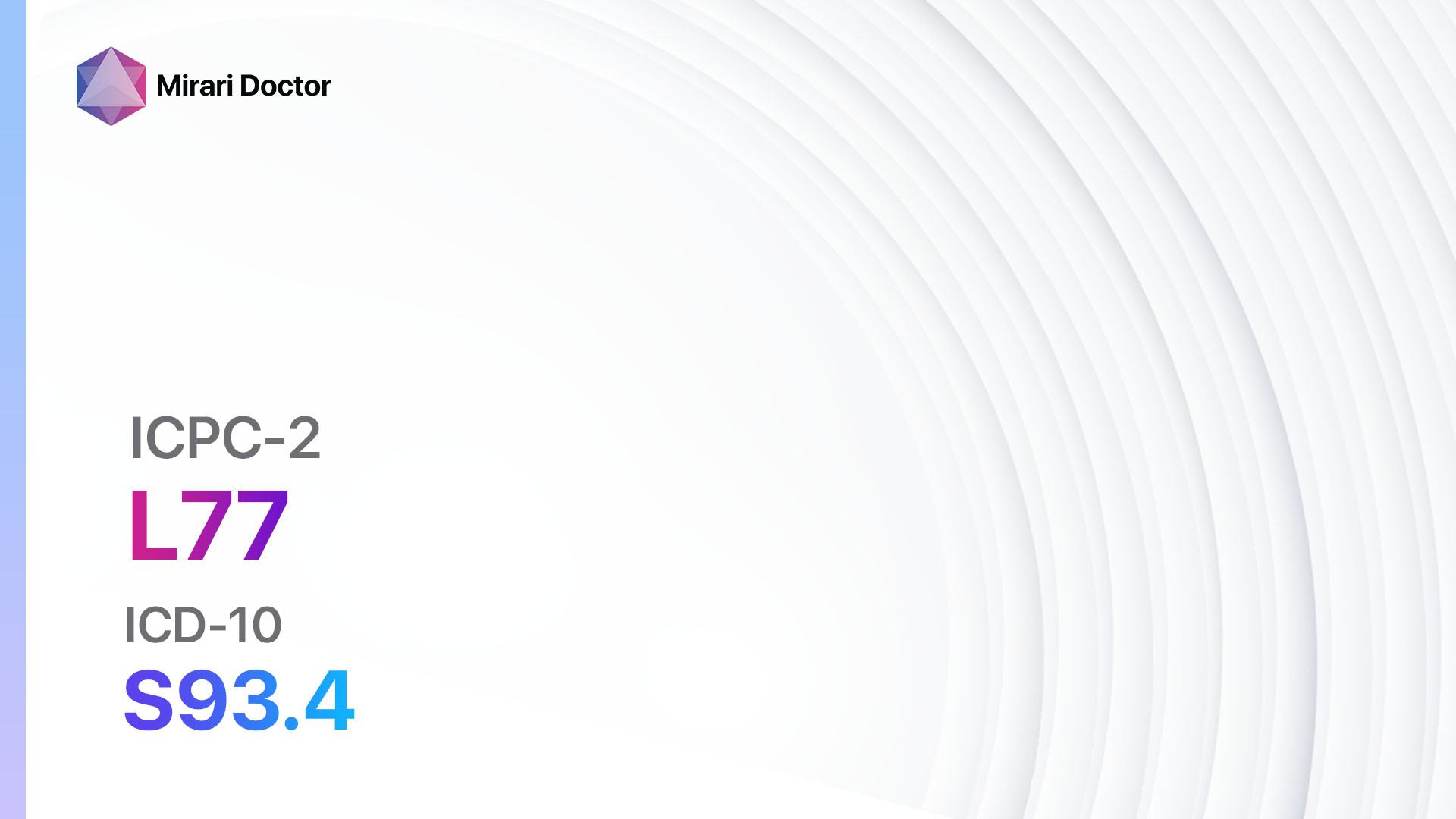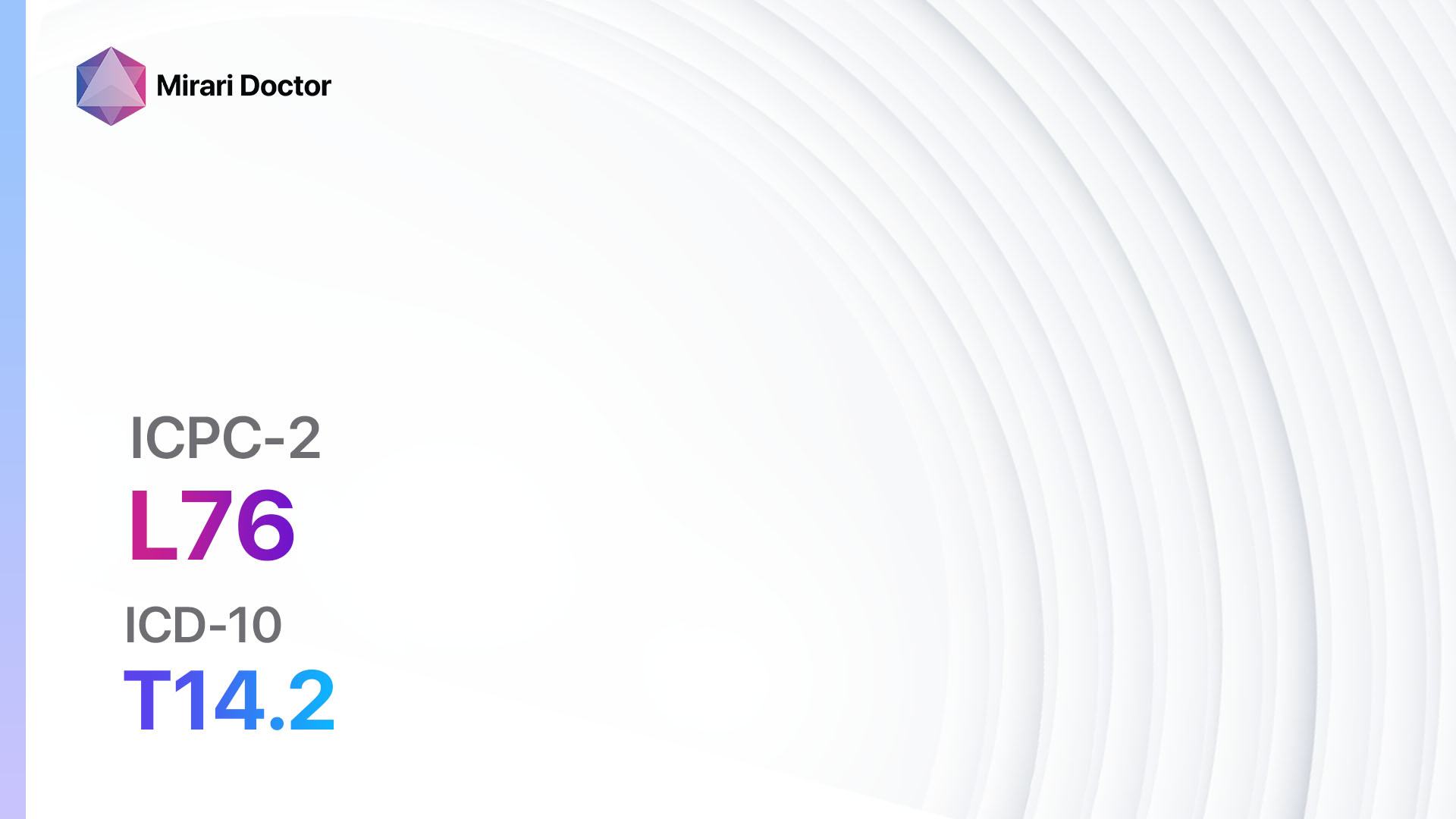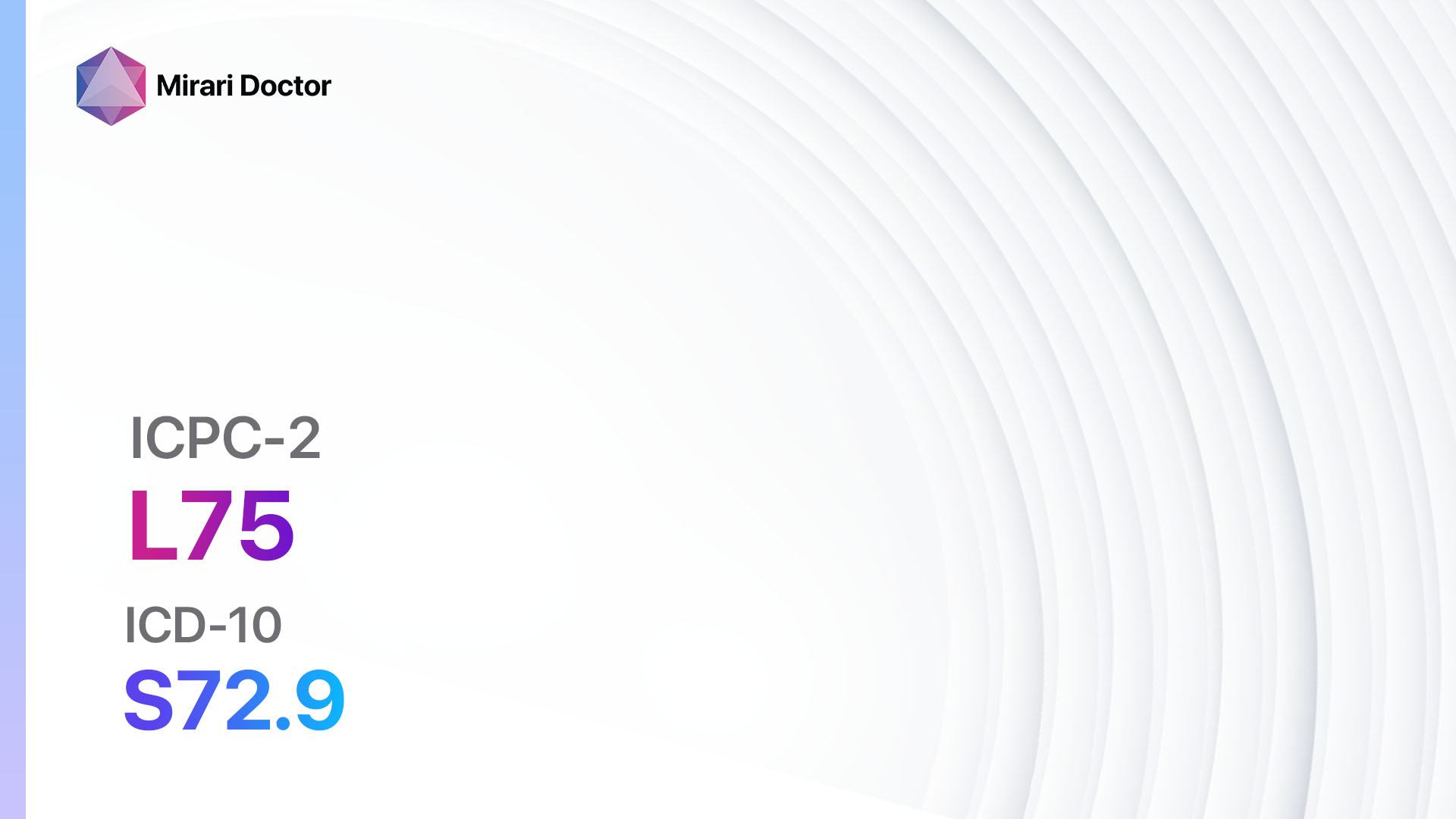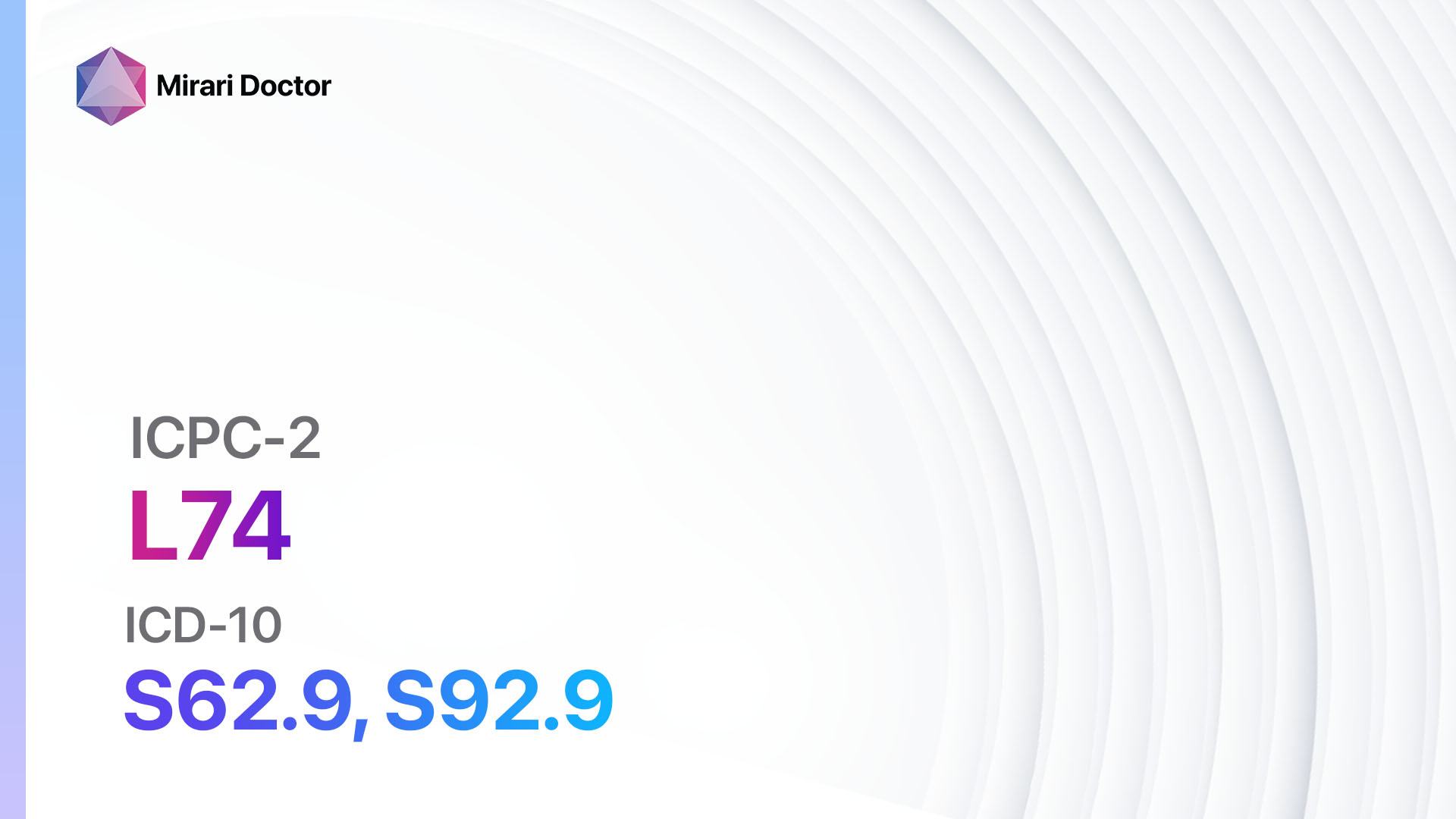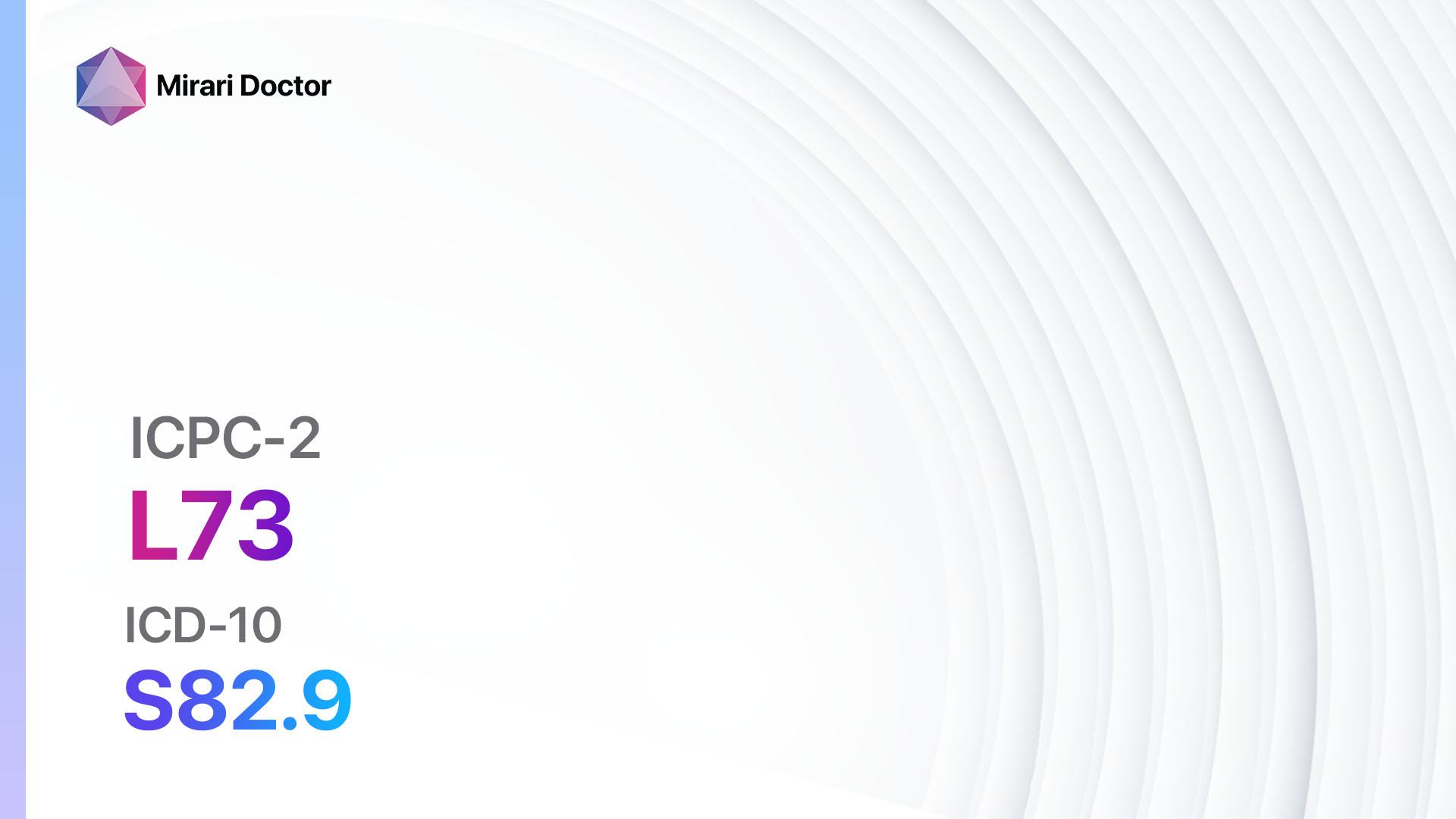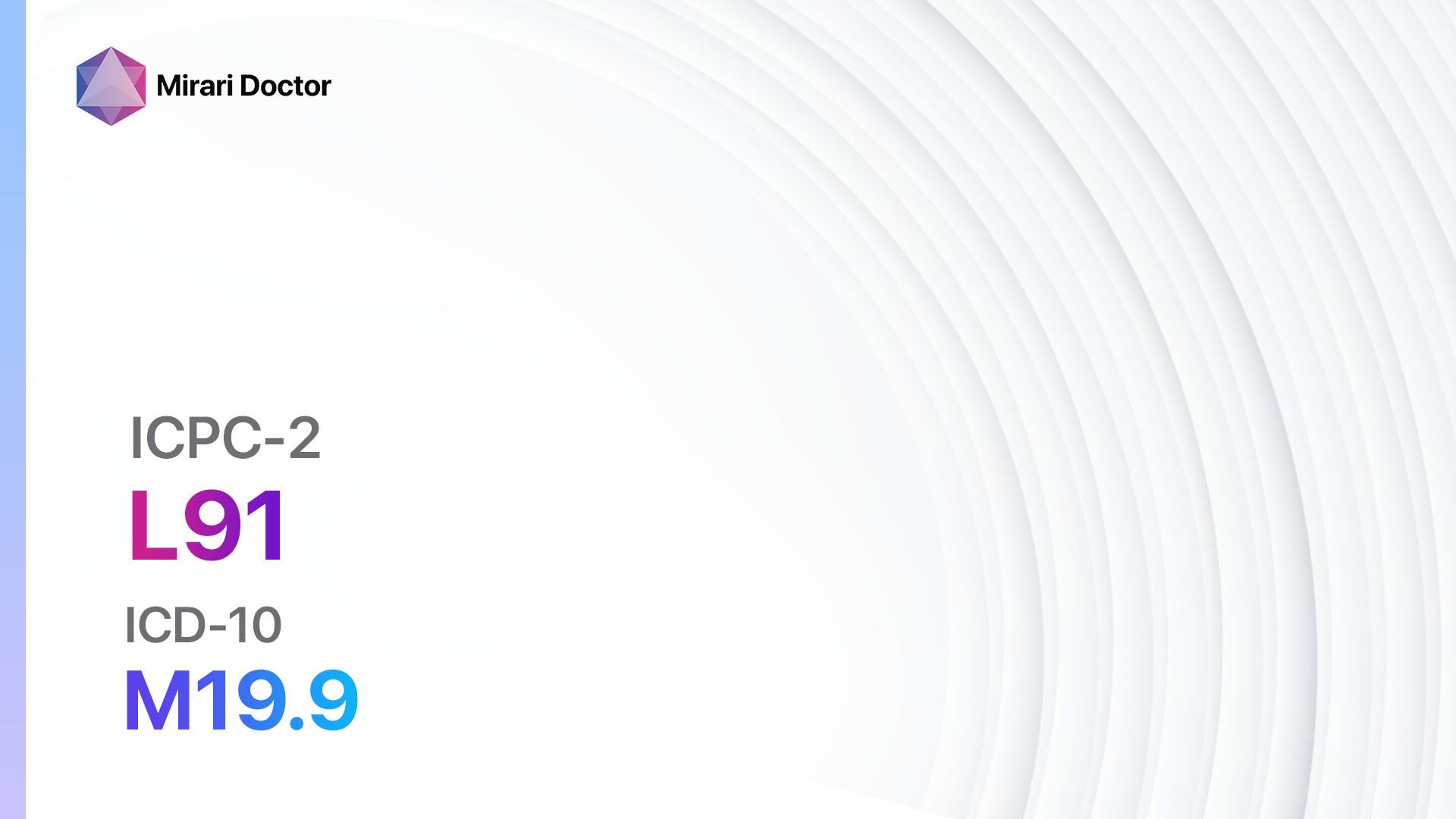
Introduction
Osteoarthrosis other, also known as osteoarthritis, is a degenerative joint disease that primarily affects the cartilage in the joints. It is a common condition that can cause pain, stiffness, and reduced mobility[1]. The aim of this guide is to provide a comprehensive overview of the symptoms, causes, diagnostic steps, possible interventions, and lifestyle interventions for osteoarthrosis other.
Codes
Symptoms
- Joint pain: Patients may experience pain in the affected joints, which can worsen with movement or activity[2].
- Joint stiffness: Stiffness in the joints, especially after periods of inactivity, is a common symptom[3].
- Reduced range of motion: Osteoarthrosis can lead to a decreased ability to move the affected joints fully[2].
- Joint swelling: In some cases, the affected joints may become swollen and tender to the touch[4].
- Joint instability: Osteoarthrosis can cause a feeling of joint instability or a sensation that the joint is giving way[5].
Causes
- Age: The risk of developing osteoarthrosis increases with age[6].
- Obesity: Excess weight puts additional stress on the joints, increasing the risk of osteoarthrosis[7].
- Joint injury: Previous joint injuries, such as fractures or ligament tears, can increase the likelihood of developing osteoarthrosis[8].
- Genetics: Some individuals may have a genetic predisposition to developing osteoarthrosis[9].
- Joint overuse: Repetitive movements or activities that put excessive strain on the joints can contribute to the development of osteoarthrosis[6].
Diagnostic Steps
Medical History
- Gather information about the patient’s symptoms, including the location, duration, and severity of joint pain.
- Identify any risk factors, such as previous joint injuries or a family history of osteoarthrosis.
- Assess the impact of the symptoms on the patient’s daily activities and quality of life[10].
Physical Examination
- Examine the affected joints for signs of swelling, tenderness, or deformity.
- Assess the range of motion in the joints and any limitations or pain experienced during movement.
- Look for signs of joint instability or joint crepitus (a crackling or grating sensation during joint movement).
Laboratory Tests
- Blood tests: Although there is no specific blood test for osteoarthrosis, certain tests can help rule out other conditions, such as rheumatoid arthritis or gout.
- Joint fluid analysis: In some cases, a sample of fluid may be taken from the affected joint to rule out other causes of joint pain, such as infection or inflammation.
Diagnostic Imaging
- X-rays: X-rays can help visualize the joint damage associated with osteoarthrosis, such as joint space narrowing, bone spurs, or cysts.
- Magnetic resonance imaging (MRI): MRI scans can provide more detailed images of the joint structures, including the cartilage, ligaments, and tendons.
- Ultrasound: Ultrasound can be used to assess the soft tissues surrounding the joint and detect any abnormalities.
Other Tests
- Bone scans: In rare cases, a bone scan may be recommended to evaluate the extent of joint damage and assess the overall bone health.
- Arthroscopy: Arthroscopy is a minimally invasive procedure that involves inserting a small camera into the joint to visualize the joint structures and diagnose any underlying issues.
Follow-up and Patient Education
- Schedule regular follow-up appointments to monitor the progression of the disease and adjust the treatment plan if necessary.
- Provide patient education materials on managing symptoms, lifestyle modifications, and available treatment options.
Possible Interventions
Traditional Interventions
Medications:
Top 5 drugs for Osteoarthrosis:
- Acetaminophen:
- Cost: Over-the-counter versions are inexpensive. Prescription-strength may range from $10-$50/month.
- Contraindications: Liver disease, alcoholism.
- Side effects: Rare, but can include liver damage in high doses.
- Severe side effects: Allergic reactions, skin rash.
- Drug interactions: Warfarin, alcohol.
- Warning: Do not exceed recommended dosage to avoid liver damage.
- Nonsteroidal anti-inflammatory drugs (NSAIDs) (e.g., Ibuprofen, Naproxen):
- Cost: Over-the-counter versions are inexpensive. Prescription-strength may range from $10-$50/month.
- Contraindications: History of stomach ulcers, kidney disease.
- Side effects: Upset stomach, heartburn.
- Severe side effects: Stomach bleeding, kidney problems.
- Drug interactions: Blood thinners, ACE inhibitors.
- Warning: Long-term use can increase the risk of heart attack or stroke.
- Topical analgesics (e.g., Capsaicin cream, Lidocaine patches):
- Cost: Varies depending on the specific product. Generally affordable.
- Contraindications: Allergy to the active ingredients.
- Side effects: Skin irritation, burning sensation.
- Severe side effects: Allergic reactions.
- Drug interactions: None reported.
- Warning: Avoid contact with eyes or broken skin.
- Corticosteroid injections:
- Cost: $100-$500 per injection.
- Contraindications: Active infection, bleeding disorders.
- Side effects: Temporary pain at the injection site.
- Severe side effects: Joint infection, tendon rupture.
- Drug interactions: None reported.
- Warning: Limit the number of injections to avoid joint damage.
- Hyaluronic acid injections:
- Cost: $300-$1000 per injection.
- Contraindications: Joint infection, skin infection at the injection site.
- Side effects: Temporary pain or swelling at the injection site.
- Severe side effects: Joint infection, allergic reactions.
- Drug interactions: None reported.
- Warning: Multiple injections may be required for optimal results.
Alternative Drugs:
- Glucosamine and chondroitin supplements: May help reduce joint pain and improve function. Cost: $20-$50/month.
- Duloxetine: An antidepressant that can also help manage chronic pain. Cost: $30-$100/month.
- Tramadol: A prescription pain medication that can be used for moderate to severe pain. Cost: $10-$50/month.
- Opioids: Reserved for severe pain that does not respond to other treatments. Cost: Varies depending on the specific medication and dosage.
Surgical Procedures:
- Joint replacement surgery: In severe cases where conservative treatments have failed, joint replacement surgery may be recommended. Cost: $20,000-$50,000 per joint.
Alternative Interventions
- Physical therapy: Physical therapy can help improve joint function, reduce pain, and increase strength and flexibility. Cost: $50-$150 per session.
- Weight loss: Losing weight can reduce the stress on the joints and improve symptoms. Cost: Varies depending on the chosen weight loss program.
- Assistive devices: The use of assistive devices, such as braces, canes, or walkers, can help reduce joint strain and improve mobility. Cost: Varies depending on the specific device.
- Acupuncture: May help reduce pain and improve joint function. Cost: $60-$120 per session.
- Transcutaneous electrical nerve stimulation (TENS): Involves the use of low-voltage electrical currents to relieve pain. Cost: $50-$100 for a TENS unit.
Lifestyle Interventions
- Exercise: Regular exercise, such as low-impact activities like swimming or cycling, can help improve joint function and reduce pain. Cost: Varies depending on the chosen exercise program or gym membership.
- Hot and cold therapy: Applying heat or cold to the affected joints can help reduce pain and inflammation. Cost: Varies depending on the chosen therapy (e.g., hot/cold packs, heating pads).
- Dietary modifications: A healthy diet rich in fruits, vegetables, and omega-3 fatty acids can help reduce inflammation and improve joint health. Cost: Varies depending on individual food choices.
- Stress management: Stress can worsen symptoms of osteoarthrosis. Stress management techniques, such as meditation or yoga, can help reduce stress levels. Cost: Varies depending on the chosen technique or class.
- Joint protection: Avoiding activities that put excessive strain on the joints and using proper body mechanics can help protect the joints and reduce symptoms. Cost: None.
It is important to note that the cost ranges provided are approximate and may vary depending on the location and availability of the interventions.
Mirari Cold Plasma Alternative Intervention
Understanding Mirari Cold Plasma
- Safe and Non-Invasive Treatment: Mirari Cold Plasma is a safe and non-invasive treatment option for various skin conditions. It does not require incisions, minimizing the risk of scarring, bleeding, or tissue damage.
- Efficient Extraction of Foreign Bodies: Mirari Cold Plasma facilitates the removal of foreign bodies from the skin by degrading and dissociating organic matter, allowing easier access and extraction.
- Pain Reduction and Comfort: Mirari Cold Plasma has a local analgesic effect, providing pain relief during the treatment, making it more comfortable for the patient.
- Reduced Risk of Infection: Mirari Cold Plasma has antimicrobial properties, effectively killing bacteria and reducing the risk of infection.
- Accelerated Healing and Minimal Scarring: Mirari Cold Plasma stimulates wound healing and tissue regeneration, reducing healing time and minimizing the formation of scars.
Mirari Cold Plasma Prescription
Video instructions for using Mirari Cold Plasma Device – L91 Osteoarthrosis other (ICD-10:M19.9)
| Mild | Moderate | Severe |
| Mode setting: 2 (Wound Healing) Location: 0 (Localized) Morning: 15 minutes, Evening: 15 minutes |
Mode setting: 2 (Wound Healing) Location: 0 (Localized) Morning: 30 minutes, Lunch: 30 minutes, Evening: 30 minutes |
Mode setting: 2 (Wound Healing) Location: 0 (Localized) Morning: 30 minutes, Lunch: 30 minutes, Evening: 30 minutes |
| Mode setting: 9 (Arthritis) Location: 0 (Localized) Morning: 15 minutes, Evening: 15 minutes |
Mode setting: 9 (Arthritis) Location: 0 (Localized) Morning: 30 minutes, Lunch: 30 minutes, Evening: 30 minutes |
Mode setting: 9 (Arthritis) Location: 0 (Localized) Morning: 30 minutes, Lunch: 30 minutes, Evening: 30 minutes |
| Mode setting: 7 (Immunotherapy) Location: 1 (Sacrum) Morning: 15 minutes, Evening: 15 minutes |
Mode setting: 7 (Immunotherapy) Location: 1 (Sacrum) Morning: 30 minutes, Lunch: 30 minutes, Evening: 30 minutes |
Mode setting: 7 (Immunotherapy) Location: 1 (Sacrum) Morning: 30 minutes, Lunch: 30 minutes, Evening: 30 minutes |
| Total Morning: 45 minutes approx. $7.50 USD, Evening: 45 minutes approx. $7.50 USD |
Total Morning: 90 minutes approx. $15 USD, Lunch: 90 minutes approx. $15 USD, Evening: 90 minutes approx. $15 USD, |
Total Morning: 90 minutes approx. $15 USD, Lunch: 90 minutes approx. $15 USD, Evening: 90 minutes approx. $15 USD, |
| Usual treatment for 7-60 days approx. $105 USD – $900 USD | Usual treatment for 6-8 weeks approx. $1,890 USD – $2,520 USD |
Usual treatment for 3-6 months approx. $4,050 USD – $8,100 USD
|
 |
|
Use the Mirari Cold Plasma device to treat Osteoarthrosis other effectively.
WARNING: MIRARI COLD PLASMA IS DESIGNED FOR THE HUMAN BODY WITHOUT ANY ARTIFICIAL OR THIRD PARTY PRODUCTS. USE OF OTHER PRODUCTS IN COMBINATION WITH MIRARI COLD PLASMA MAY CAUSE UNPREDICTABLE EFFECTS, HARM OR INJURY. PLEASE CONSULT A MEDICAL PROFESSIONAL BEFORE COMBINING ANY OTHER PRODUCTS WITH USE OF MIRARI.
Step 1: Cleanse the Skin
- Start by cleaning the affected area of the skin with a gentle cleanser or mild soap and water. Gently pat the area dry with a clean towel.
Step 2: Prepare the Mirari Cold Plasma device
- Ensure that the Mirari Cold Plasma device is fully charged or has fresh batteries as per the manufacturer’s instructions. Make sure the device is clean and in good working condition.
- Switch on the Mirari device using the power button or by following the specific instructions provided with the device.
- Some Mirari devices may have adjustable settings for intensity or treatment duration. Follow the manufacturer’s instructions to select the appropriate settings based on your needs and the recommended guidelines.
Step 3: Apply the Device
- Place the Mirari device in direct contact with the affected area of the skin. Gently glide or hold the device over the skin surface, ensuring even coverage of the area experiencing.
- Slowly move the Mirari device in a circular motion or follow a specific pattern as indicated in the user manual. This helps ensure thorough treatment coverage.
Step 4: Monitor and Assess:
- Keep track of your progress and evaluate the effectiveness of the Mirari device in managing your Osteoarthrosis other. If you have any concerns or notice any adverse reactions, consult with your health care professional.
Note
This guide is for informational purposes only and should not replace the advice of a medical professional. Always consult with your healthcare provider or a qualified medical professional for personal advice, diagnosis, or treatment. Do not solely rely on the information presented here for decisions about your health. Use of this information is at your own risk. The authors of this guide, nor any associated entities or platforms, are not responsible for any potential adverse effects or outcomes based on the content.
Mirari Cold Plasma System Disclaimer
- Purpose: The Mirari Cold Plasma System is a Class 2 medical device designed for use by trained healthcare professionals. It is registered for use in Thailand and Vietnam. It is not intended for use outside of these locations.
- Informational Use: The content and information provided with the device are for educational and informational purposes only. They are not a substitute for professional medical advice or care.
- Variable Outcomes: While the device is approved for specific uses, individual outcomes can differ. We do not assert or guarantee specific medical outcomes.
- Consultation: Prior to utilizing the device or making decisions based on its content, it is essential to consult with a Certified Mirari Tele-Therapist and your medical healthcare provider regarding specific protocols.
- Liability: By using this device, users are acknowledging and accepting all potential risks. Neither the manufacturer nor the distributor will be held accountable for any adverse reactions, injuries, or damages stemming from its use.
- Geographical Availability: This device has received approval for designated purposes by the Thai and Vietnam FDA. As of now, outside of Thailand and Vietnam, the Mirari Cold Plasma System is not available for purchase or use.
References
- Arthritis Foundation. (2021). Osteoarthritis (OA). Retrieved from https://www.arthritis.org/diseases/osteoarthritis
- Mayo Clinic. (2021). Osteoarthritis – Symptoms and causes. Retrieved from https://www.mayoclinic.org/diseases-conditions/osteoarthritis/symptoms-causes/syc-20351925
- National Institute of Arthritis and Musculoskeletal and Skin Diseases. (2019). Osteoarthritis. Retrieved from https://www.niams.nih.gov/health-topics/osteoarthritis
- Centers for Disease Control and Prevention. (2020). Osteoarthritis (OA). Retrieved from https://www.cdc.gov/arthritis/basics/osteoarthritis.htm
- American Academy of Orthopaedic Surgeons. (2021). Osteoarthritis. Retrieved from https://orthoinfo.aaos.org/en/diseases–conditions/osteoarthritis/
- Zhang, Y., & Jordan, J. M. (2010). Epidemiology of osteoarthritis. Clinics in geriatric medicine, 26(3), 355-369.
- Bliddal, H., Leeds, A. R., & Christensen, R. (2014). Osteoarthritis, obesity and weight loss: evidence, hypotheses and horizons–a scoping review. Obesity reviews, 15(7), 578-586.
- Muthuri, S. G., McWilliams, D. F., Doherty, M., & Zhang, W. (2011). History of knee injuries and knee osteoarthritis: a meta-analysis of observational studies. Osteoarthritis and cartilage, 19(11), 1286-1293.
- Warner, S. C., & Valdes, A. M. (2016). Genetic association studies in osteoarthritis: is it fairytale?. Current opinion in rheumatology, 28(2), 106-113.
- Altman, R. D. (2010). Early management of osteoarthritis. The American journal of managed care, 16, S41-7.
Related articles
Made in USA


